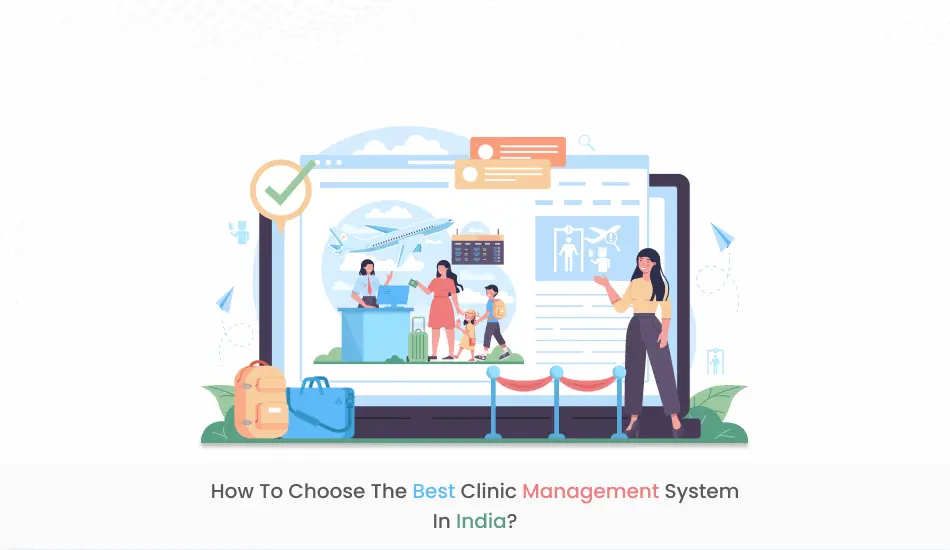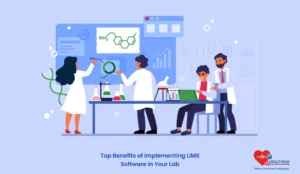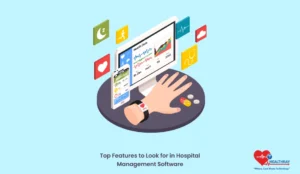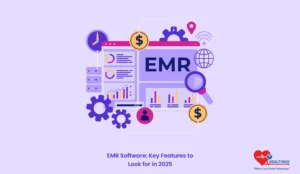Quick Summary:
Consider customization possibilities, integration capabilities, customer support, ease of use, and compliance with regional laws and customs when selecting India’s best clinic management system. Make sure to do extensive research and consider customer reviews before choosing.
Introduction
When we’re sick, visiting the hospital is frequently the first thing that comes to mind. On the other hand, a far higher proportion of Indians receive daily medical care in non-hospital settings. Both governmental and private clinics are housed in these more compact healthcare facilities. The clinics include small private consulting firms, dispensaries, polyclinics, and government primary healthcare institutions. The main reasons people choose to go to their neighborhood clinic rather than a hospital are accessibility, reduced consultation fees, and a stronger rapport with the doctors. The majority of Indian clinics are now the first port of call for patients looking for institutionalized healthcare, even though they lack the workforce and resources needed to handle the surge of people and patient loads while maintaining high standards of treatment.
Clinics require affordable solutions to handle the various issues approximately information administration, operations, organization, restorative charging, and other aspects of healthcare conveyance. Utilizing a clinic administration framework, small-sized healthcare suppliers can make strides in the treatment quality by tending to the most persevering issues they experience. Furthermore, it will help them in upgrading the system’s adaptability and deftness. Moreover, these advanced apparatuses can offer assistance clinics end up versatile and ensure progression in healthcare administrations over computerized and physical mediums in dubious periods like the COVID outbreak. In any case, what accurately is a clinic management system?
What is a clinic management software?
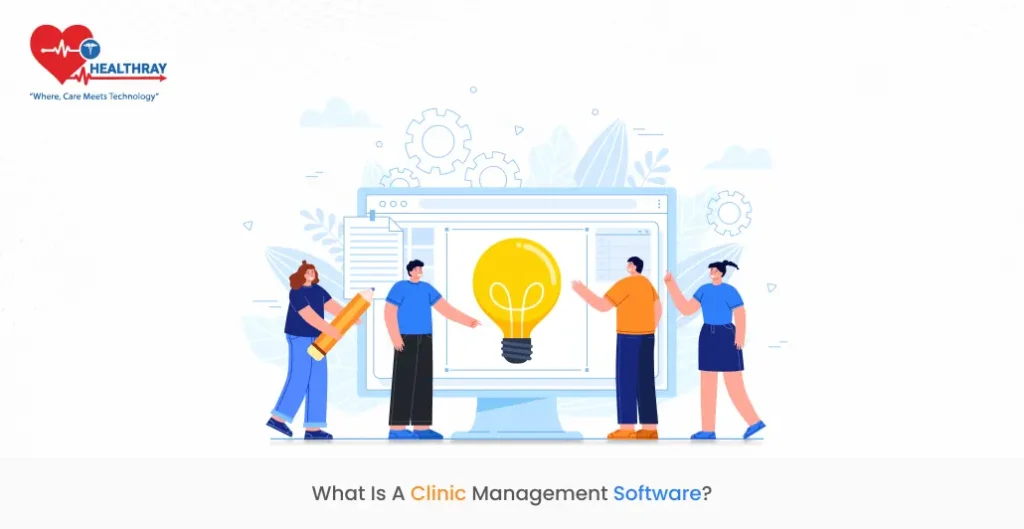
In essence, a clinic management system is software that improves patient care and boosts productivity in medical practices. A standard clinic workflow comprises the subsequent elements. A patient schedules a visit at the clinic with a practicing doctor. At the time of the visit, patient data is recorded. The doctor recommends health matters as soon as they meet the patient. As a result, the patient might be responsible for paying for the cost of any prescription medications or particular testing.
Subsequently, the understanding would utilize the clinic’s laboratory and pharmacy as required. Based on the administrations given, a treatment charge is produced. In this manner, clinic administration and operations incorporate overseeing staffing levels and keeping up the clinic and its numerous offices, such as the drug store, crisis room, housekeeping, and research facility, in expansion to the treatment and income cycle administration. In expansion, the clinic needs to keep track of different supplies and stock and collaborate with other parties, counting providers of restorative hardware and demonstrative labs.
A noteworthy sum of dreary work, information era, record keeping, and adherence to a few administrative and compliance prerequisites are vital for the energetic operation of clinics. Coordination of a few assignments and methods is encouraged by a software-as-a-service (SaaS) clinic administration framework, coming about in a more productive and profitable operation of therapeutic clinics that benefits representatives and patients.
Why should clinics use clinic management software?

Clinics should use clinic management system software because of its many benefits. The SaaS format makes installing, implementing, and integrating the solution with other systems easy. The plug-and-play technology can handle all OPD requirements, including scheduling appointments and receiving prescriptions and lab findings. The following is a list of some key features and advantages of clinic management software.
Encourages uniformity in healthcare provision and central management: A robust SaaS clinic management system aids in the geographic expansion of clinic operations. Numerous chain clinics operate in multiple locations. They believe that the system contributes to the centralization of branch administration, resulting in uniform operations and consistent healthcare delivery quality.
Facilitates scheduling of appointments: Scheduling, rescheduling, and appointment booking are all made easy and convenient by the program. It may effortlessly convey information in distinct, personalized formats to physicians and patients simultaneously, confirming appointments or cancellations.
Combines accounting and billing: Bills are produced at a clinic for services rendered at different care delivery locations. Bills are often created at the following points: registration, consultation, diagnostic testing, physical therapy, and pharmacy. It facilitates precise record-keeping of a clinic’s billing and accounting needs, guaranteeing clear, organized, and error-free financial transaction documentation.
Precise and secure data handling: Compared to hospitals, clinics see more return patients and produce more data. Patients must register with the program first before their data may be retrieved. Clinics might keep lab results and patient health records on file for future use. The technology, supported by cloud computing technologies, makes storing large amounts of electronic health records simple and error-free. Reputable SaaS solutions make investments in globally recognized data security technologies. Therefore, the digitization of all clinic data, including patient medical records too, enables data storage that is safe and secure.
Steps to choose the best clinic management software
Check your needs & requirements.
Don’t purchase any program just because everyone else is. Because every clinic is different and has different needs and objectives, it might not be beneficial to follow the herd. Provide special attention to a top clinic management system that automates and simplifies procedures, for instance, if your clinic is tiny and only has one location. Your employees can work more productively and concentrate on other duties. However, if you run a multi-center clinic, you must consider potential integrations with current systems.
Therefore, carefully evaluating your clinic’s particular demands and requirements is the first step in choosing clinic management and software vendors. It entails being aware of your practice’s scope and complexity, the specific duties and processes you must oversee, and the degree of necessary system integration. You may begin by posing the following queries to yourself:
What are the main obstacles you have to overcome to run your clinic?
Which particular procedures or administrative tasks are you looking to streamline?
Which components are necessary to run your clinic?
What degree of system integration is required, including billing software and electronic health records (EHRs)?
What is your ultimate objective? To expand, to boost output, or for some other purpose?
Evaluate your features & functionality.
Assessing the features and functionalities of various software programs comes next after you clearly understand your clinic’s requirements. Give top priority to clinic management system features that align with your clinic’s operations and immediately address the issues you’ve discovered.
Interoperability
Practice management software must integrate well with other applications in the healthcare ecosystem to utilize all of its advantages. These programs include billing systems, data warehousing solutions, electronic health records (EHRs), and appointment scheduling systems. Healthcare practices can function smoothly and effectively when these programs are integrated. Thus, be sure to enquire with your provider about the integration capabilities and compatibility of the various medical practice management software.
Appointment Scheduling
Since an effective patient appointment scheduling system is the cornerstone of a profitable clinic, it is an essential component that cannot be compromised. Seek online clinic administration software solutions to consolidate bookings and inquiries from several sources onto a single platform. Additionally, inquire about the possibility of process automation, appointment reminders, and walk-in capture.
Patient record management
To improve treatment outcomes and streamline patient care, this tool will assist you in keeping up-to-date, accessible patient records. When scheduling an appointment, patients also trust you with their private information. As a result, you must guarantee that the patient information is protected and that regulatory obligations are met. Thus, enquire about the rules, compliances, and security measures.
Low-code or no-code solution
When selecting the best software for clinic administration, it’s crucial to look for no-code automation with zero or no downtime.
Implementation and support
Select clinic management software by looking for an easy-to-use interface that may be quickly used. Ensure they offer full support, including omnichannel 24/7 assistance for integration and execution. Later, when modifications arise, this will help you manage them, from little process adjustments to extensive workflow overhauls. Feel free to request staff training to familiarize your team system.
How do you choose among all clinic management system options?
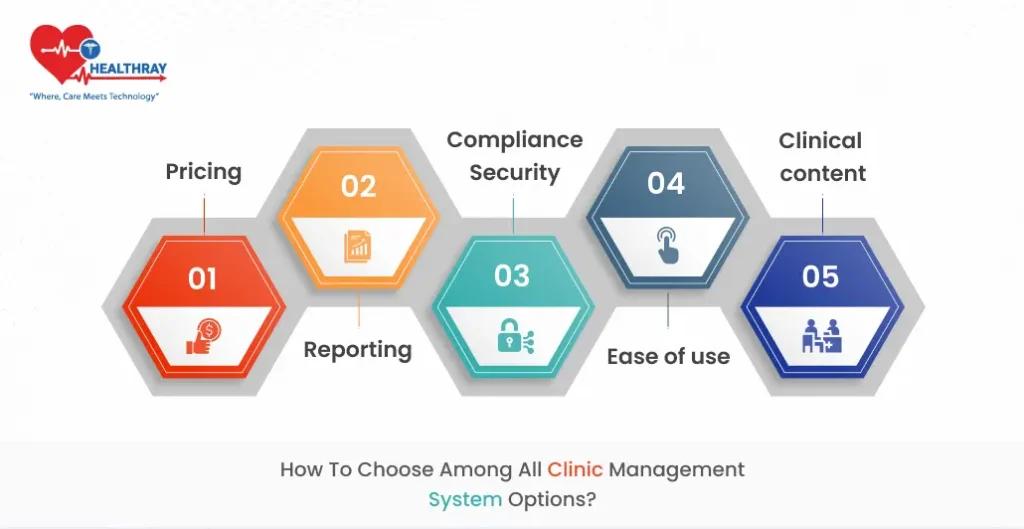
Clinic management systems are presently basic instruments for healthcare offices in the computerized age, making a difference in moving forward persistent care and streamlining operations. Choosing the best one for your clinic might be overpowering, even though numerous alternatives are in the advertisement. To make an educated choice, you must take into account several perspectives that may have a significant impact on your choice. It is a broad, direct clarification of how to select from all the medical clinic software administration framework choices.
Pricing
Estimating is one of the primary components to consider when selecting a clinic management system. Finding an arrangement that works inside your budget is crucial, but it’s too essential to make. Without any doubt, you’re getting the highlights and usefulness you require. Look for stages with clear, forthright cost structures void of extra costs. Look at whether the estimating structure fits the estimate, volume of patients, and long-term targets of your clinic.
Reporting
Following persistent results, assessing clinic execution, and pinpointing regions for change depends on proficient detailing apparatuses. Select a clinic administration framework with solid announcing capabilities, such as real-time analytics, customized dashboards, and the capacity to give in-depth reports on imperative measurements like understanding socioeconomics patient demographics, arrangement planning, salary, and clinical outcomes.
Compliance & Security
Clinic management systems must prioritize data security and compliance with healthcare standards. Ensure the selected system complies with applicable regulations, such as GDPR (General Data Protection Regulation) and HIPAA (Health Insurance Portability and Accountability Act). Search for features like audit trails, data encryption, access controls, and frequent security updates to further preserve patient privacy and security.
Ease of use
Optimizing efficiency and diminishing preparation time requires an intuitive client interface and route. Select a user-friendly clinic administration framework for both regulatory staff and therapeutic experts. See for highlights like drag-and-drop capabilities, customizable workflows, screen size, and device-adaptable responsive plans.
Clinical content
The caliber and breadth of clinical material in the management system can significantly impact patient care and decision-making. Ensure the system provides thorough clinical templates, protocols, and recommendations specific to your expertise or practice. To ensure smooth information sharing and continuity of care, look for features like clinical decision support tools, electronic health record (EHR) integration, and interoperability with other healthcare systems.
Integration of EHR
Coordination of clinical documentation and data compatibility with electronic health records (EHR) is fundamental to optimizing productivity and precision. Select a clinic administration framework with built-in EHR capability or one interatomically compatible with your current EHR framework. To encourage interoperability with other healthcare frameworks and suppliers, the framework must be consistent with industry-standard information compatibility designs like HL7 (Health Level Seven).
Support & training
A consistent framework setup and ceaseless upkeep method depend on the benefits to the client and the broad preparation of materials. Select a supplier that gives individual phone, mail, and live chat help, along with staff that is knows and has speedy reaction times. Look for providers offering broad preparing courses, client guides, and on-site instruction customized for your medical clinic in expansion to online instructional exercises.
Choose Healthray’s clinic management software to excel at your practice!
To succeed in your medical practice, choose the clinic administration software from Healthray! Our cutting-edge framework outlines broad capabilities to fulfill the specific necessities of healthcare experts. Healthray progresses in persistent care by streamlining forms and advertising that is capable of detailing and compliance capabilities in expansion to straightforward planning and charging highlights. Our computer program empowers your practice to thrive in the changing healthcare and promotes advertising by consistently joining electronic health records (EHR) and giving uncommon clients bolster. Healthray’s clinic management software allows you to enjoy the best development, precision, and productivity.
Conclusion
Clinical management systems (CMS) can be easily coordinated with numerous stages and applications, including patient portal, billing, pharmacy administration, lab, etc. One of the primary benefits is that, in questionable times, clinics can quickly move to give telemedicine administrations by receiving such innovation and going advanced, ensuring coherence in the arrangement of understanding care.
Above all, a clinic management system is quite economical. Clinics can obtain the technology through creative models like subscription and pay-per-use formats, significantly increasing its viability. By maximizing resource utilization and reducing waste, the technology makes operations green and clean and helps clinics save money. Activating a Clinic Management System allows administrators to significantly alter the business, operations, and healthcare delivery experience.
